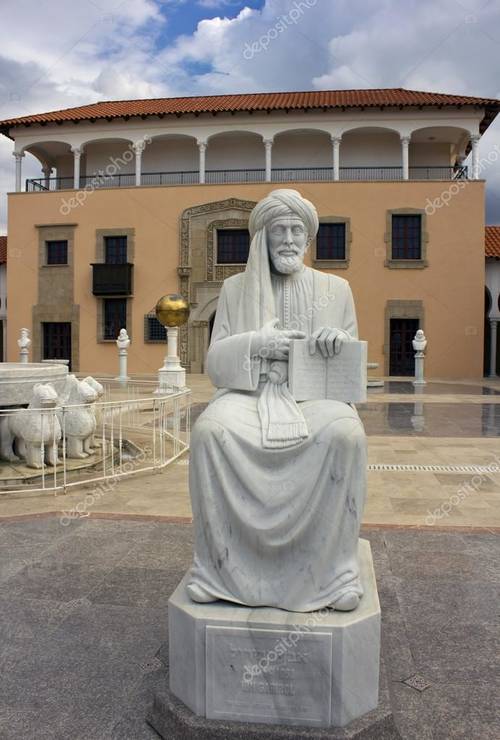Yehuda ibn Gabirol
08/16/2018 11:02:15 AM
Dr. Mariana Montiel
| Author | |
| Date Added | |
| Automatically create summary | |
| Summary |
Solomon ben Yehuda ibn Gabirol was born in Málaga (Andalusia) around 1021, and died in Valencia in 1058. His health was a problem from childhood (ulcerations that frequently caused repugnance in others), and his agitated life and constant relocation eventually caused his death at an early age. Ibn Gabirol´s parents brought him to Zaragoza, in northern Spain, as a child and they both died soon after. The Jewish Quarter was very organized and the community acquired the responsibility for educating and sustaining this very talented, but problematic, 12-year-old orphan. Jonah Ibn Janah, a prominent grammarian, lexicographer, and physician protected this child prodigy, and gave him both Jewish learning and treatment for his serious skin affliction.
Much of Ibn Gabirol´s liturgical poetry is used in both Sephardic and Ashkenazy rituals. He is considered to be the author of Adon Olam, sung at Shabbat services until our days. He had an exceptional capacity to write poetry in Hebrew, and is considered to have pioneered the use of Hebrew as a secular language in this type of art form. His lifestyle changed drastically when Yekutiel, a Jewish minister in Zaragoza´s court, became his protector. As an example of his precocity – and arrogance, which would cause him many problems –:
My song is a crown for kings
and mitres on the heads of governors.
My body walks upon the earth,
While my spirit ascends to the clouds.
Behold me:
at sixteen my heart like that of a man of eighty is wise.
However Yekutiel was assassinated in 1039, when Gabirol was 18. He wrote a 200-verse lament for his protector, eternalizing Yekutiel. An excerpt illustrates his heartfelt loss:
Behold the sun at evening, red…
The earth – she leaves it bare and cold
To huddle in shadows through the night.
At once the sky is dark;
Sackcloth it wore for Yekutiel.
After Yekutiel’s death Gabirol left Zaragoza. He traveled constantly and lived for a time in Granada, protected by Samuel HaNagid (future protagonist of our Sephardic Corner). Eventually he went to Valencia, where he died before turning 40.
A constant in his poetry is the preeminence of knowledge, which he considers the highest value:
Sapience is mother to my soul,
Wisdom is my sister.
She is the one I treasure more than pearls.
The world is just my concubine.
Until the 19th century Avicebron was considered a Hispano-Arab Christian. In 1857, a German Jewish orientalist, S. Munk, published a partial Hebrew version of the philosophical work The Source of Life (originally written in Arabic and famous due to the Latin version). The Hebrew translator, Sem Tob ibn Falachera, had cited the author as the great poet Ibn Gabirol. It seems that Latin scholars, only interested in Gabirol’s philosophical (Platonic) works, ignorant of his Hebrew poetry, had deformed the name Ibn Gabirol into Avicebron! This curious split of the same person was favored by the variety of subjects that Ibn Gabirol encompassed and his short life.
Our post-Spanish-expulsion story will consist of a sequence of episodes over the next few months, given that our protagonist, and the emblematic places where she traveled during her life, require more space. Beatriz de Luna, better known as Beatriz Mendes or, mythically famous as Gracia Nasi, la Señora, has been called the Queen Esther of the sixteenth century.
When the expulsion from Spain was decreed in 1492, many Jews went to Portugal. However, in 1497 the expulsion/forced conversion was decreed in Portugal, given that King Manuel was to marry a daughter of the Catholic Kings of Spain, who stipulated that condition. As there was no Inquisition in Portugal until 1536, it was common that the Jews would accept Christianism in appearance, but would practice Judaism hiddenly. These Jews are known historically as marranos.
Gracia Nasi was born in Portugal as Beatriz de Luna in 1510, into a family of crypto Jews. In 1528 she married Francisco Mendes, whose surname was adopted by the Benveniste family, a family of rabbis and scholars. Francisco was a rab ha anusim, a rabbi for conversos. When a rabbi was required for a marriage or other types of ceremonies, people would come to Francisco. Under her husband´s guidance, Beatiz learned Hebrew, Torah, and could understand her own origin.
Francisco, together with his brother, were in charge of the Portuguese king´s merchant ships. The economic success of the Mendes brothers gave them a fortune that they used in the creation of the Mendes Bank, that became the second most important bank of Europe in the sixteenth century.
However, the situation of the Jews became more complicated when the Inquisition was introduced in Portugal in 1536. In 1538 Francisco died. As in his ten years of marriage with Beatriz he had come to appreciate her superior intelligence and flawless criteria, he left her his entire fortune and the complete capacity to make decisions about the future of the shipping business and the bank.
That same year Beatriz, her daughter Reyna and her brother-in-law Diego Mendes (Meir Benveniste) went to Antwerp, Belgium, Europe´s financial center at that time.
It was in Antwerp where Beatriz Mendes began to assume the colossal figure of Gracia Nasi. She used the commercial route of the Mendes ships to help the Portuguese Jews escape from the Inquisition, as the company had free flow from Lisbon to Antwerp, and then to Ancona, Italy. Some refugees stayed in Ancona and others continued on to the Ottoman Empire. Gracia made sure that the property and assets of these Jews were bought by her company in Portugal, deposited in the Mendes Bank, and received by their owners once they reached their destiny.
In 1545, Gracia left Antwerp with Reyna, to escape from the forced marriage of her daughter with a nobleman from Charles V´s court (Flanders was still under Spanish rule). They fled to Venice and, in spite of the policy of the ghetto (Venice was the first place in Europe to use this term), Gracia and Reyna could live in an elegant house in the zone they chose. However, shortly after their arrival they were imprisoned for Judaizing. Through the intervention of Suleiman the Magnificent, counseled by his doctor Moshe Haman (a member of the dynasty of Jewish physicians, first in the courts of the Spanish kings and then in the palaces of the Turkish sultans) they were freed. Suleiman wanted Gracia to move, with her fortune and business of course, to the Ottoman Empire, but she decided to go to Ferrara, Italy. Her stay in Ferrara and eventual move to the Ottoman Empire will be the subject of the second part of our next article.
Tue, April 1 2025
3 Nisan 5785
Building Blocks Sunday School
Prayer Services
Coming Soon at OVS
-
Saturday ,
AprApril 12 , 2025Shabbat Together
Shabbat, Apr 12th 10:30a to 11:30a
Join us for our new Kavanagh Minyan & Children's Services the second Saturday each month. Following these services, we'll join the group in the Sanctuary for Rabbi Hearshen's sermon followed by Kiddush lunch. It’s as easy as: Inviting your friends and family for Shabbat Dinner, Taking a few photos, Sharing the photos with OVS & One Table And... Receiving a stipend for each person at your dinner. -
Tuesday ,
AprApril 15 , 2025Passover Picnic & a Walk in the Park
Tuesday, Apr 15th 11:30a to 1:00p
Bring your own picnic lunch and catch up your OVS friends. Join us for a walk along the boardwalk after we eat. Exact location will be emailed prior to the picnic. Free of charge. -
Thursday ,
MayMay 1 , 2025Sephardic Dinner to Go
Thursday, May 1st 2:00p to 4:00p
Dinner To Go includes 1 dozen burekas (potato, spinach or rice, while supplies last), 1 quart Avas (tomato based white bean soup), 1 quart rice, tossed garden salad and 6 biscochos. Pre-orders only by Monday, April 28. -
Sunday ,
AugAugust 17 , 2025Building Blocks Sunday School 2025-2026
Sunday, Aug 17th 9:00a to 12:00p
Building Blocks Sunday School at Congregation Or VeShalom is for children ages 2 - 12. Areas of focus include prayer, Jewish holidays, Jewish values, modern Hebrew, Hebrew reading, Israel, and Sephardic Jewish culture.
Burekas & Biscochos
The Sephardic Cooks
My Preferences for Contact
Today's Calendar
| Bureka Making : 9:30am |
This week's Torah portion is Parshat Vayikra
| Shabbat, Apr 5 |
Candle Lighting
| Friday, Apr 4, 7:42pm |
Havdalah
| Motzei Shabbat, Apr 5, 8:36pm |
Taanit Bechorot
| Thursday, Apr 10 |
OVS Feature Video
Congregation Or VeShalom
404-633-1737 | office@orveshalom.org
1681 N Druid Hills Road | Brookhaven, GA 30319
Privacy Settings | Privacy Policy | Member Terms
©2025 All rights reserved. Find out more about ShulCloud


